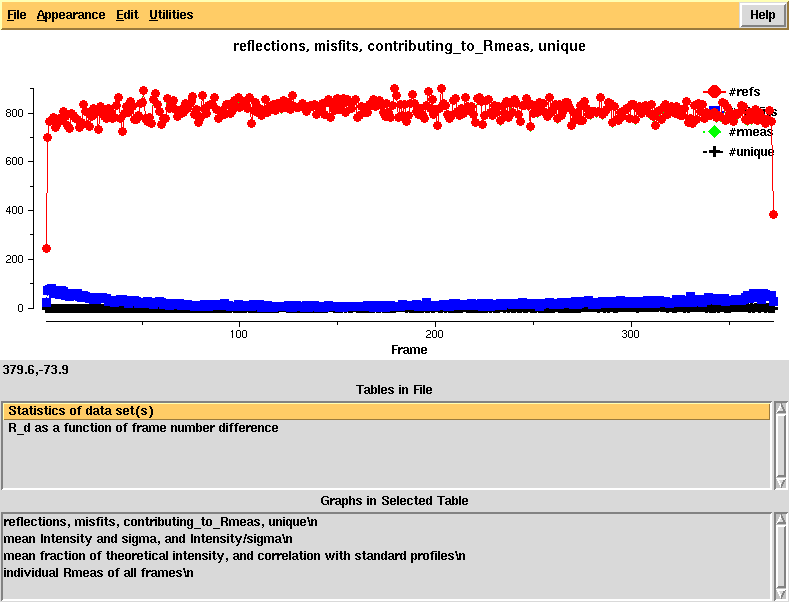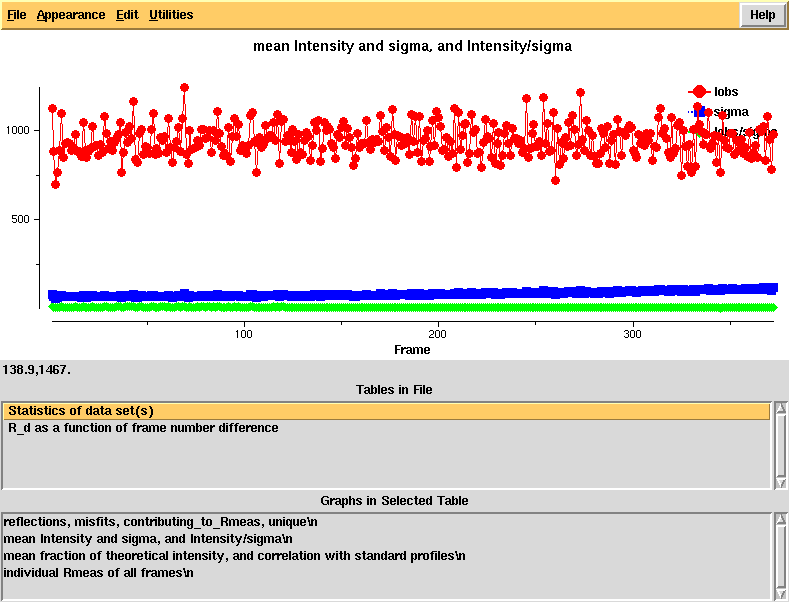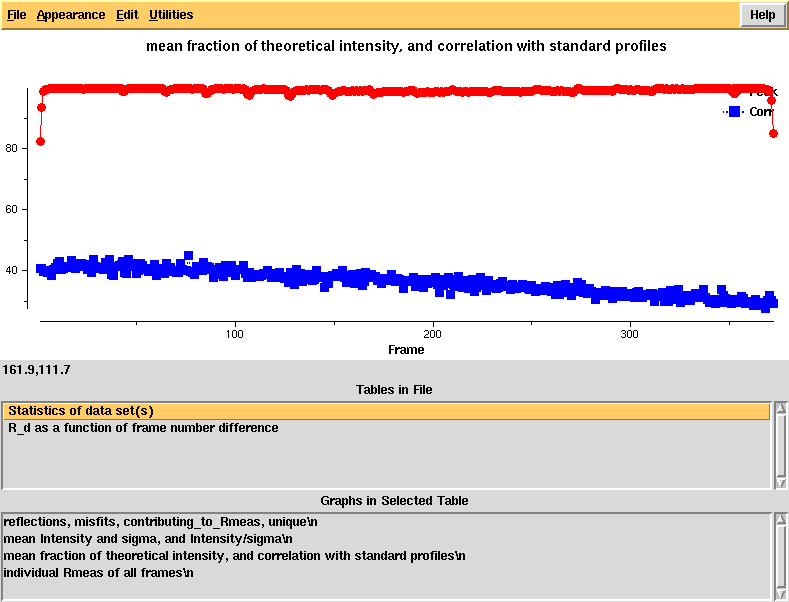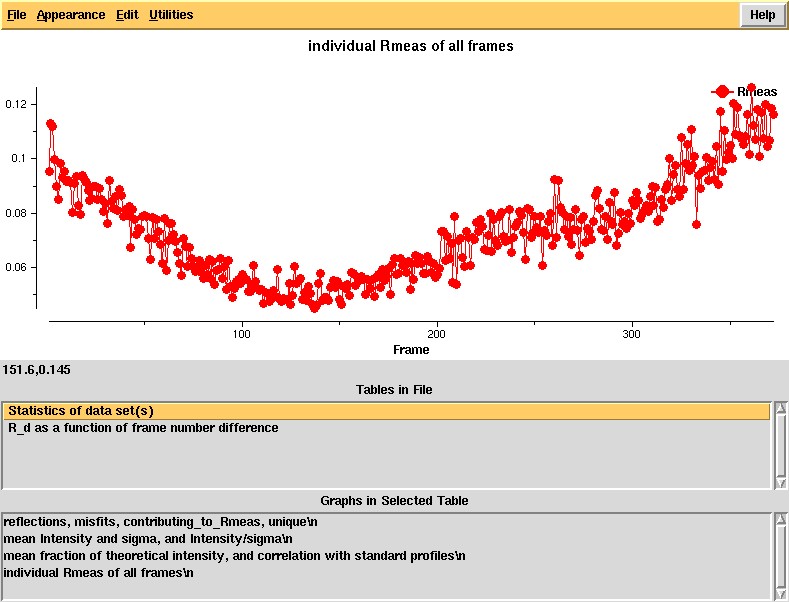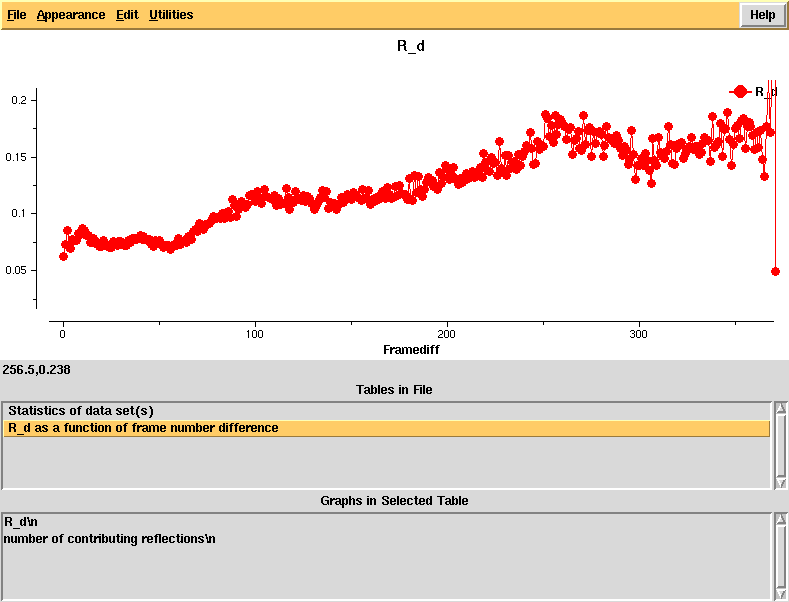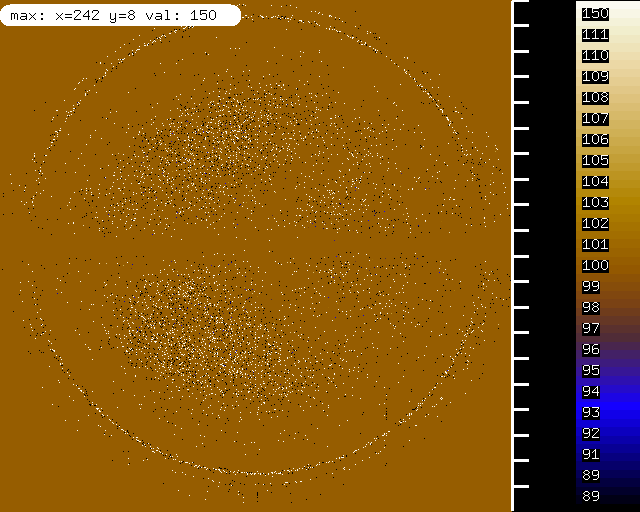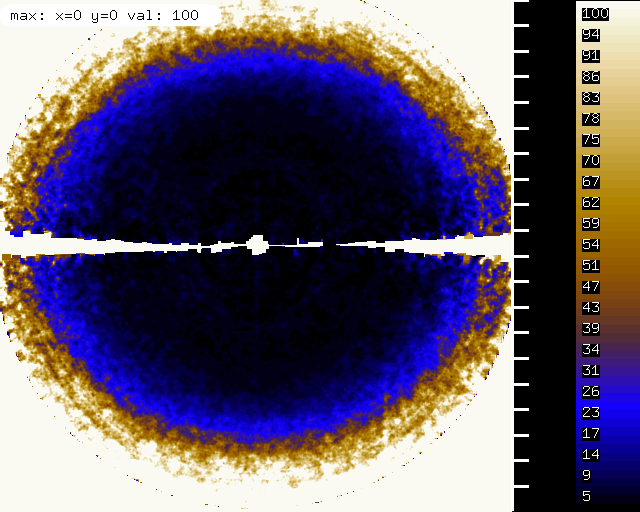1Y13: Difference between revisions
No edit summary |
|||
| Line 325: | Line 325: | ||
NOTE: Friedel pairs are treated as different reflections. | NOTE: Friedel pairs are treated as different reflections. | ||
SUBSET OF INTENSITY DATA WITH SIGNAL/NOISE >= -3.0 AS FUNCTION OF RESOLUTION | SUBSET OF INTENSITY DATA WITH SIGNAL/NOISE >= -3.0 AS FUNCTION OF RESOLUTION | ||
RESOLUTION NUMBER OF REFLECTIONS COMPLETENESS R-FACTOR R-FACTOR COMPARED I/SIGMA R-meas Rmrgd-F Anomal SigAno Nano | RESOLUTION NUMBER OF REFLECTIONS COMPLETENESS R-FACTOR R-FACTOR COMPARED I/SIGMA R-meas Rmrgd-F Anomal SigAno Nano | ||
| Line 353: | Line 353: | ||
The anomalous correlation is good at low resolution, though not outstanding. At high resolution it rises again but this is presumably due to the ice rings. | The anomalous correlation is good at low resolution, though not outstanding. At high resolution it rises again but this is presumably due to the ice rings. | ||
I like to use [[ccp4com:hkl2map|hkl2map]] which runs [[ccp4com:SHELX C/D/E|SHELXC]], [[ccp4com:SHELX C/D/E|SHELXD]] and [[ccp4com:SHELX C/D/E|SHELXE]] from its GUI. Before doing so, we have to run XDSCONV with the following XDSCONV.INP: | |||
INPUT_FILE=firstparts.hkl | |||
OUTPUT_FILE=temp.hkl SHELX | |||
First, the shelxc output which shows that these data are quite good: | |||
[[File:e1+e2_firstparts-i-sigi-resol.png]] [[File:e1+e2_firstparts-self-anomcc.png]] | |||
And then 100 trials of shelxd, trying to find 3 Se atoms at 30-3.3 resolution (I also tried 3.0 3.1 3.2 3.4 3.5 but 3.3 was best). | |||
[[File:e1+e2_firstparts-ccall-ccweak.png]] [[File:e1+e2_firstparts-occ-vs-peak.png]] | |||
This looks reasonable although the absolute value of CCall is so low that there is little hope that the structure can be solved with this amount of information. And indeed, SHELXE did not show a difference between the two hands (in fact we even know that the "original hand" is the correct one since the inverted had would correspond to spacegroup #92 !). | |||
Revision as of 15:48, 17 March 2011
The structure is deposited in the PDB, solved with SAD and refined at a resolution of 2.2 A in spacegroup P4(3)2(1)2 (#96). The data for this project were provided by Jürgen Bosch (SGPP) and are linked to the ACA 2011 workshop website. There are two high-resolution (2 Å) datasets E1 (wavelength 0.9794Å) and E2 (@ 0.9174Å) collected (with 0.25° increments) at an ALS beamline on June 27, 2004, and a weaker dataset collected earlier at a SSRL beamline. We will only use the former two datasets here.
Dataset E1
Use generate_XDS.INP and run xds once. Based on R-factors in the resulting CORRECT.LP, and an inspection of BKGPIX.cbf, I modified XDS.INP to have
INCLUDE_RESOLUTION_RANGE=40 2.1 ! too weak beyond 2.1 Å VALUE_RANGE_FOR_TRUSTED_DETECTOR_PIXELS=8000. 30000. ! raised from 7000 30000 to mask beamstop
and ran xds again.
What's the problem?
This is the excerpt from CORRECT.LP :
SPACE-GROUP UNIT CELL CONSTANTS UNIQUE Rmeas COMPARED LATTICE-
NUMBER a b c alpha beta gamma CHARACTER
5 145.8 145.7 131.4 90.0 90.0 90.0 9735 24.5 23176 10 mC
75 103.1 103.1 131.4 90.0 90.0 90.0 5262 23.4 27649 11 tP
89 103.1 103.1 131.4 90.0 90.0 90.0 2911 22.8 30000 11 tP
21 145.7 145.8 131.4 90.0 90.0 90.0 5270 23.2 27641 13 oC
5 145.7 145.8 131.4 90.0 90.0 90.0 9681 24.2 23230 14 mC
1 102.9 103.2 131.4 90.0 90.0 89.9 18040 6.9 14871 31 aP
* 16 102.9 103.2 131.4 90.0 90.0 90.0 5568 9.1 27343 32 oP
3 103.2 102.9 131.4 90.0 90.0 90.0 10536 9.5 22375 35 mP
3 102.9 103.2 131.4 90.0 90.0 90.0 10496 8.3 22415 33 mP
3 102.9 131.4 103.2 90.0 90.1 90.0 9770 7.3 23141 34 mP
1 102.9 103.2 131.4 90.0 90.0 90.1 18040 6.9 14871 44 aP
...
REFINED PARAMETERS: DISTANCE BEAM ORIENTATION CELL AXIS
USING 219412 INDEXED SPOTS
STANDARD DEVIATION OF SPOT POSITION (PIXELS) 1.01
STANDARD DEVIATION OF SPINDLE POSITION (DEGREES) 0.11
CRYSTAL MOSAICITY (DEGREES) 0.191
DIRECT BEAM COORDINATES (REC. ANGSTROEM) -0.004789 0.003758 1.021015
DETECTOR COORDINATES (PIXELS) OF DIRECT BEAM 1027.25 1064.20
DETECTOR ORIGIN (PIXELS) AT 1036.84 1056.68
CRYSTAL TO DETECTOR DISTANCE (mm) 209.38
LAB COORDINATES OF DETECTOR X-AXIS 1.000000 0.000000 0.000000
LAB COORDINATES OF DETECTOR Y-AXIS 0.000000 1.000000 0.000000
LAB COORDINATES OF ROTATION AXIS 0.999997 0.000527 0.002187
COORDINATES OF UNIT CELL A-AXIS 21.922 52.895 85.337
COORDINATES OF UNIT CELL B-AXIS 3.771 87.158 -54.992
COORDINATES OF UNIT CELL C-AXIS -128.130 18.914 21.191
REC. CELL PARAMETERS 0.009731 0.009697 0.007620 90.000 90.000 90.000
UNIT CELL PARAMETERS 102.766 103.125 131.241 90.000 90.000 90.000
E.S.D. OF CELL PARAMETERS 1.3E-01 8.6E-02 9.3E-02 0.0E+00 0.0E+00 0.0E+00
SPACE GROUP NUMBER 16
So CORRECT chooses an orthorhombic spacegroup.
The file continues:
...
a b ISa
6.058E+00 3.027E-04 23.35
...
NOTE: Friedel pairs are treated as different reflections.
SUBSET OF INTENSITY DATA WITH SIGNAL/NOISE >= -3.0 AS FUNCTION OF RESOLUTION
RESOLUTION NUMBER OF REFLECTIONS COMPLETENESS R-FACTOR R-FACTOR COMPARED I/SIGMA R-meas Rmrgd-F Anomal SigAno Nano
LIMIT OBSERVED UNIQUE POSSIBLE OF DATA observed expected Corr
6.23 17389 5807 6045 96.1% 2.4% 2.8% 17277 35.83 3.0% 2.0% 66% 1.553 2434
4.43 32116 10536 10787 97.7% 2.7% 3.0% 32057 33.78 3.3% 2.4% 55% 1.272 4762
3.62 41900 13700 13961 98.1% 3.4% 3.4% 41793 27.98 4.1% 3.6% 38% 1.115 6295
3.14 51146 16371 16513 99.1% 5.4% 5.3% 50967 18.89 6.6% 7.2% 20% 0.961 7625
2.81 59159 18627 18675 99.7% 12.7% 13.2% 58877 9.82 15.4% 18.0% 8% 0.818 8716
2.56 65525 20596 20651 99.7% 28.5% 30.2% 65130 5.19 34.5% 40.4% 3% 0.757 9629
2.37 71579 22491 22533 99.8% 62.6% 67.1% 71068 2.60 75.6% 88.8% 1% 0.694 10498
2.22 74065 23837 24094 98.9% 97.9% 97.0% 73444 1.59 118.8% 139.8% 11% 0.738 11051
2.09 65776 24379 25674 95.0% 133.3% 140.6% 63647 0.90 166.4% 216.0% 1% 0.651 10380
total 478655 156344 158933 98.4% 6.5% 6.8% 474260 10.65 7.9% 22.5% 16% 0.852 71390
NUMBER OF REFLECTIONS IN SELECTED SUBSET OF IMAGES 492346
NUMBER OF REJECTED MISFITS 13342
NUMBER OF SYSTEMATIC ABSENT REFLECTIONS 0
NUMBER OF ACCEPTED OBSERVATIONS 479004
NUMBER OF UNIQUE ACCEPTED REFLECTIONS 157108
Some comments:
- the "STANDARD DEVIATION OF SPOT POSITION (PIXELS)" is significantly higher (1.01) than those reported for the 5°-batches in INTEGRATE.LP (about 0.6) . This suggests that the geometry refinement has to deal with inconsistent data.
- CORRECT obviously indicates an orthorhombic spacegroup.
- the number of MISFITS is higher than 1%. From the first long table (fine-grained in resolution) table in CORRECT.LP we learn that the misfits are due to faint high-resolution ice rings - so this is a problem intrinsic to the data, and not to their mode of processing.
To my surprise, pointless does not agree with CORRECT's standpoint:
Scores for each symmetry element
Nelmt Lklhd Z-cc CC N Rmeas Symmetry & operator (in Lattice Cell)
1 0.959 9.91 0.99 65030 0.034 identity
2 0.959 9.91 0.99 132222 0.035 *** 2-fold l ( 0 0 1) {-h,-k,+l}
3 0.958 9.87 0.99 110073 0.044 *** 2-fold h ( 1 0 0) {+h,-k,-l}
4 0.942 9.55 0.96 132646 0.109 *** 2-fold ( 1 1 0) {+k,+h,-l}
5 0.958 9.87 0.99 111819 0.043 *** 2-fold k ( 0 1 0) {-h,+k,-l}
6 0.941 9.54 0.95 131842 0.109 *** 2-fold ( 1-1 0) {-k,-h,-l}
7 0.937 9.50 0.95 224393 0.107 *** 4-fold l ( 0 0 1) {-k,+h,+l} {+k,-h,+l}
and
Laue Group Lklhd NetZc Zc+ Zc- CC CC- Rmeas R- Delta ReindexOperator > 1 P 4/m m m *** 1.000 9.73 9.73 0.00 0.97 0.00 0.07 0.00 0.2 [h,k,l] - 2 P m m m 0.000 0.35 9.88 9.53 0.99 0.95 0.04 0.11 0.0 [h,k,l] 3 C m m m 0.000 -0.02 9.72 9.74 0.97 0.97 0.07 0.07 0.2 [h+k,-h+k,l] 4 P 4/m 0.000 0.07 9.77 9.70 0.98 0.97 0.06 0.08 0.2 [h,k,l] 5 P 1 2/m 1 0.000 0.25 9.91 9.66 0.99 0.97 0.03 0.08 0.0 [-h,-l,-k] 6 P 1 2/m 1 0.000 0.22 9.89 9.67 0.99 0.97 0.04 0.08 0.0 [h,k,l] 7 P 1 2/m 1 0.000 0.21 9.88 9.67 0.99 0.97 0.04 0.08 0.0 [-k,-h,-l] 8 C 1 2/m 1 0.000 -0.01 9.72 9.73 0.97 0.97 0.07 0.07 0.2 [h-k,h+k,l] 9 C 1 2/m 1 0.000 -0.02 9.71 9.73 0.97 0.97 0.07 0.07 0.2 [h+k,-h+k,l] 10 P -1 0.000 0.21 9.91 9.70 0.99 0.97 0.03 0.08 0.0 [h,k,l]
and
Spacegroup TotProb SysAbsProb Reindex Conditions
<P 41 21 2> ( 92) 0.823 0.823 00l: l=4n, h00: h=2n (zones 1,2)
<P 43 21 2> ( 96) 0.823 0.823 00l: l=4n, h00: h=2n (zones 1,2)
..........
<P 4 21 2> ( 90) 0.095 0.095 h00: h=2n (zone 2)
..........
<P 42 21 2> ( 94) 0.077 0.077 00l: l=2n, h00: h=2n (zones 1,2)
Thus suggesting #92 or #96 - the latter of which agrees with the PDB deposition. However, running CORRECT in #96 and specifying 103 103 130 90 90 90 as cell parameters, we obtain:
REFINED PARAMETERS: DISTANCE BEAM ORIENTATION CELL AXIS
USING 220320 INDEXED SPOTS
STANDARD DEVIATION OF SPOT POSITION (PIXELS) 1.17
STANDARD DEVIATION OF SPINDLE POSITION (DEGREES) 0.14
CRYSTAL MOSAICITY (DEGREES) 0.191
DIRECT BEAM COORDINATES (REC. ANGSTROEM) -0.004790 0.004009 1.021014
DETECTOR COORDINATES (PIXELS) OF DIRECT BEAM 1027.19 1064.23
DETECTOR ORIGIN (PIXELS) AT 1036.79 1056.20
CRYSTAL TO DETECTOR DISTANCE (mm) 209.52
LAB COORDINATES OF DETECTOR X-AXIS 1.000000 0.000000 0.000000
LAB COORDINATES OF DETECTOR Y-AXIS 0.000000 1.000000 0.000000
LAB COORDINATES OF ROTATION AXIS 0.999996 0.000901 0.002534
COORDINATES OF UNIT CELL A-AXIS 21.926 53.087 85.553
COORDINATES OF UNIT CELL B-AXIS 3.794 87.060 -54.995
COORDINATES OF UNIT CELL C-AXIS -128.212 18.926 21.115
REC. CELL PARAMETERS 0.009704 0.009704 0.007616 90.000 90.000 90.000
UNIT CELL PARAMETERS 103.045 103.045 131.310 90.000 90.000 90.000
E.S.D. OF CELL PARAMETERS 2.1E-01 2.1E-01 2.1E-01 0.0E+00 0.0E+00 0.0E+00
SPACE GROUP NUMBER 96
...
a b ISa
7.890E+00 8.793E-04 12.01
...
NOTE: Friedel pairs are treated as different reflections.
SUBSET OF INTENSITY DATA WITH SIGNAL/NOISE >= -3.0 AS FUNCTION OF RESOLUTION
RESOLUTION NUMBER OF REFLECTIONS COMPLETENESS R-FACTOR R-FACTOR COMPARED I/SIGMA R-meas Rmrgd-F Anomal SigAno Nano
LIMIT OBSERVED UNIQUE POSSIBLE OF DATA observed expected Corr
6.23 16770 2983 3017 98.9% 5.2% 6.1% 16752 26.20 5.7% 2.6% 55% 1.247 1223
4.43 30598 5392 5393 100.0% 5.8% 6.2% 30596 25.25 6.3% 3.0% 50% 1.072 2420
3.62 39822 6992 6994 100.0% 6.9% 6.6% 39820 22.27 7.6% 4.0% 32% 0.975 3215
3.14 49620 8240 8242 100.0% 9.2% 8.7% 49619 17.14 10.1% 6.2% 19% 0.876 3847
2.81 59388 9379 9379 100.0% 17.7% 18.1% 59387 10.44 19.3% 12.3% 0% 0.736 4410
2.56 65652 10308 10310 100.0% 34.6% 39.1% 65652 6.08 37.7% 23.6% -1% 0.680 4872
2.37 71744 11258 11259 100.0% 71.3% 83.8% 71744 3.23 77.6% 52.1% -2% 0.652 5352
2.22 74888 12065 12082 99.9% 111.0% 116.9% 74888 1.98 121.2% 86.9% 2% 0.718 5753
2.09 65727 12386 12874 96.2% 151.3% 176.1% 65517 1.12 168.0% 148.4% -3% 0.631 5797
total 474209 79003 79550 99.3% 10.3% 11.0% 473975 9.44 11.3% 17.2% 13% 0.772 36889
NUMBER OF REFLECTIONS IN SELECTED SUBSET OF IMAGES 492346
NUMBER OF REJECTED MISFITS 17898
NUMBER OF SYSTEMATIC ABSENT REFLECTIONS 141
NUMBER OF ACCEPTED OBSERVATIONS 474307
NUMBER OF UNIQUE ACCEPTED REFLECTIONS 79022
which is much worse than the spacegroup 19 statistics (compare the ISa values - they differ by a factor of 2 !) so there may be something wrong with some assumptions we were making ...
Identifying a possible cause
The easiest thing one can do is to inspect INTEGRATE.LP - this lists scale factor, beam divergence and mosaicity for every reflection. There's a jiffy called "scalefactors" which grep's the relevant lines from INTEGRATE.LP ("scalefactors > scales.log"). This shows the scale factor (column 3):
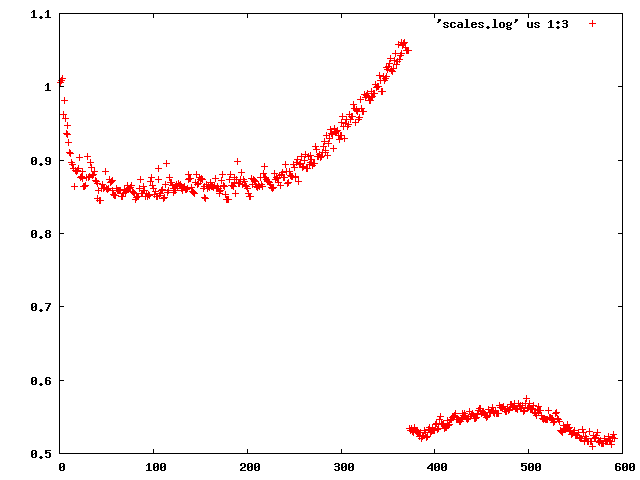
demonstrating that "something happens" between frame 372 and 373 (of course one has to look at the table to find the exact numbers).
It should be noted that any abrupt change in conditions during the experiment is going to spoil the resulting data in one way or another. This is most true for a SAD experiment which is supposed to give accurate values for the tiny differences in intensities between Friedel-related reflections.
A solution
At this point it is good to look at the data for experiment E2. Here, we find exactly the same problems of bad ISa and high "STANDARD DEVIATION OF SPOT POSITION (PIXELS)" when reducing frames 1-591 in one run of xds.
With this knowledge, we are lead, for E1, to reduce frames 1-372 and 373-592 separately, in spacegroup 96. For E2, we use frames 1-369 and 371-591, respectively. Frame E2-370 has a very high scale factor so we leave it out altogether.
This is also a good time to closely inspect the headers of the frames:
% grep --binary-files=text DATE j1603b3PK_1_E1_37?.img
gives
j1603b3PK_1_E1_370.img:DATE=Sun Jun 27 08:55:51 2004; j1603b3PK_1_E1_371.img:DATE=Sun Jun 27 08:56:00 2004; j1603b3PK_1_E1_372.img:DATE=Sun Jun 27 08:56:08 2004; j1603b3PK_1_E1_373.img:DATE=Sun Jun 27 09:19:45 2004; j1603b3PK_1_E1_374.img:DATE=Sun Jun 27 09:19:54 2004; j1603b3PK_1_E1_375.img:DATE=Sun Jun 27 09:20:02 2004; j1603b3PK_1_E1_376.img:DATE=Sun Jun 27 09:20:10 2004; j1603b3PK_1_E1_377.img:DATE=Sun Jun 27 09:20:58 2004; j1603b3PK_1_E1_378.img:DATE=Sun Jun 27 09:21:08 2004; j1603b3PK_1_E1_379.img:DATE=Sun Jun 27 09:21:17 2004;
and
% grep --binary-files=text DATE j1603b3PK_1_E2_3[67]?.img
gives
j1603b3PK_1_E2_366.img:DATE=Sun Jun 27 08:55:15 2004; j1603b3PK_1_E2_367.img:DATE=Sun Jun 27 08:55:23 2004; j1603b3PK_1_E2_368.img:DATE=Sun Jun 27 08:55:32 2004; j1603b3PK_1_E2_369.img:DATE=Sun Jun 27 08:56:19 2004; j1603b3PK_1_E2_370.img:DATE=Sun Jun 27 08:56:28 2004; j1603b3PK_1_E2_371.img:DATE=Sun Jun 27 09:19:26 2004; j1603b3PK_1_E2_372.img:DATE=Sun Jun 27 09:19:34 2004; j1603b3PK_1_E2_373.img:DATE=Sun Jun 27 09:20:22 2004; j1603b3PK_1_E2_374.img:DATE=Sun Jun 27 09:20:30 2004; j1603b3PK_1_E2_375.img:DATE=Sun Jun 27 09:20:38 2004; j1603b3PK_1_E2_376.img:DATE=Sun Jun 27 09:20:47 2004;
thus proving that both datasets were interrupted for 20 minutes around frame 370.
The really weird thing here is that both datasets appear to be collected at the same time, but at different wavelengths (E1 at 0.9794 Å, E2 at 0.9184 Å), and yet the individual parts merge as follows: using the following XSCALE.INP:
UNIT_CELL_CONSTANTS=103.316 103.316 131.456 90.000 90.000 90.000 SPACE_GROUP_NUMBER=96 OUTPUT_FILE=temp.ahkl INPUT_FILE=../e1_1-372/XDS_ASCII.HKL INPUT_FILE=../e1_373-592/XDS_ASCII.HKL INPUT_FILE=../e2_1-369/XDS_ASCII.HKL INPUT_FILE=../e2_371-591/XDS_ASCII.HKL
and running xscale, we obtain in XSCALE.LP:
CORRELATIONS BETWEEN INPUT DATA SETS AFTER CORRECTIONS DATA SETS NUMBER OF COMMON CORRELATION RATIO OF COMMON B-FACTOR #i #j REFLECTIONS BETWEEN i,j INTENSITIES (i/j) BETWEEN i,j 1 2 15943 0.978 1.0002 0.0106 1 3 22366 1.000 1.0012 -0.0008 2 3 15801 0.977 0.9983 0.0557 1 4 15648 0.979 0.9988 0.0541 2 4 14862 0.999 1.0024 -0.0007 3 4 15524 0.978 0.9999 -0.0015
which means that e1_1-372 correlates well (1.000) with e2_1-369, and e1_373-59 well (0.999) with e2_371-591, but the crosswise correlations are consistently low (0.978, 0.977, 0.979, 0.978). The adjustment to the error model proves this:
a b ISa ISa0 INPUT DATA SET 6.112E+00 1.429E-03 10.70 22.37 ../e1_1-372/XDS_ASCII.HKL 1.074E+01 1.825E-03 7.14 23.79 ../e1_373-592/XDS_ASCII.HKL 5.707E+00 1.621E-03 10.40 22.82 ../e2_1-369/XDS_ASCII.HKL 8.547E+00 1.796E-03 8.07 24.17 ../e2_371-591/XDS_ASCII.HKL
telling us that "if we merge these datasets together, their error estimates have to be increased a lot". However, if we switch to
UNIT_CELL_CONSTANTS=103.316 103.316 131.456 90.000 90.000 90.000 SPACE_GROUP_NUMBER=96 OUTPUT_FILE=firstparts.ahkl INPUT_FILE=../e1_1-372/XDS_ASCII.HKL INPUT_FILE=../e2_1-369/XDS_ASCII.HKL OUTPUT_FILE=secondparts.ahkl INPUT_FILE=../e1_373-592/XDS_ASCII.HKL INPUT_FILE=../e2_371-591/XDS_ASCII.HKL
we obtain
a b ISa ISa0 INPUT DATA SET 6.120E+00 3.673E-04 21.09 22.37 ../e1_1-372/XDS_ASCII.HKL 5.713E+00 3.819E-04 21.41 22.82 ../e2_1-369/XDS_ASCII.HKL 5.639E+00 3.151E-04 23.72 23.79 ../e1_373-592/XDS_ASCII.HKL 5.289E+00 3.258E-04 24.09 24.17 ../e2_371-591/XDS_ASCII.HKL
proving that the second parts of datasets E1 and E2 should be treated separately from the first parts.
Upon inspection of the cell parameters, we find that the cell axes of the second "halfs" are shorter by a factor of 0.9908 when compared with the first parts. This suggests that they were collected at a longer wavelength! But then the wavelength values in the headers are most likely completely wrong: we can speculate that the two first parts were collected at the SeMet peak wavelength, and the two second parts at the inflection wavelength.
The almost-simultaneous DATEs in the headers may be explained by an inverse-beam measuring strategy which alternatingly collects 4 frames in one orientation as E1, then rotates the spindle by 180° and collects 4 frames into E2. For some reason, the beamline software did not write the correct wavelength into the headers.
So this little detective work appears to tell us what happened in the morning of Sunday June 27, 2004 at ALS beamline 821.
Further analysis of datasets E1 and E2
Here, we try to learn more about the constituents of "firstparts".
Running "xdsstat > XDSSTAT.LP" in the e1_1-372 and e2_1-369 directories, we obtain statistics output not available from CORRECT. We open XDSSTAT.LP with the CCP4 program "loggraph", and take a look at misfits.pck, rf.pck, and the other files produced by xdsstat, using VIEW or XDS-Viewer:
Reflections and misfits, by frame - looks normal
Intensity and sigma by frame - looks normal
"partiality" and profile agreement, by frame - looks good but it's clear that the profiles at high frame number agree worse with the average profiles, possibly due to radiation damage
R_meas, by frame, clearly showing good R_meas in the middle of the dataset
R_d - an R-factor which directly depends on radiation damage. This is calculated as a function of frame number difference and the linear rise indicates significant radiation damage that should be correctable in XSCALE, using the CRYSTAL_NAME keyword.
misfits mapped on the detector, showing ice rings.
R_meas mapped on the detector, showing elevated R_meas at the location of the ice rings.
Solving the structure
Although we could now think of using these two files ("firstparts" and "secondparts" merged) and assume that they are peak and inflection wavelengths, it appears more reasonable to try and solve the structure with SAD - which means using "firstparts" only.
Let's look at the XSCALE statistics for "firstparts":
NOTE: Friedel pairs are treated as different reflections.
SUBSET OF INTENSITY DATA WITH SIGNAL/NOISE >= -3.0 AS FUNCTION OF RESOLUTION
RESOLUTION NUMBER OF REFLECTIONS COMPLETENESS R-FACTOR R-FACTOR COMPARED I/SIGMA R-meas Rmrgd-F Anomal SigAno Nano
LIMIT OBSERVED UNIQUE POSSIBLE OF DATA observed expected Corr
9.40 6122 844 883 95.6% 2.9% 3.5% 6111 54.76 3.2% 1.4% 79% 2.137 313
6.64 12037 1611 1621 99.4% 2.9% 3.6% 12035 51.54 3.1% 1.5% 80% 2.259 684
5.43 15348 2065 2086 99.0% 3.5% 3.7% 15347 47.79 3.7% 1.7% 78% 2.294 908
4.70 18714 2487 2498 99.6% 3.0% 3.7% 18711 49.55 3.2% 1.5% 72% 1.712 1120
4.20 21104 2797 2821 99.1% 3.1% 3.7% 21102 47.24 3.3% 1.7% 72% 1.727 1271
3.84 23316 3095 3117 99.3% 3.8% 4.0% 23313 42.74 4.1% 2.1% 65% 1.617 1420
3.55 25693 3345 3366 99.4% 4.4% 4.5% 25693 37.93 4.7% 2.6% 50% 1.411 1548
3.32 28017 3633 3653 99.5% 5.2% 5.2% 28015 32.89 5.6% 3.6% 40% 1.335 1687
3.13 30266 3842 3848 99.8% 7.2% 7.2% 30264 25.87 7.7% 4.8% 36% 1.158 1797
2.97 32595 4114 4118 99.9% 10.4% 10.4% 32594 19.26 11.1% 7.7% 30% 1.068 1925
2.83 34384 4315 4320 99.9% 14.3% 14.8% 34382 14.88 15.3% 10.3% 20% 0.937 2031
2.71 35654 4475 4478 99.9% 18.3% 19.1% 35652 12.13 19.5% 13.1% 15% 0.891 2110
2.61 37307 4705 4710 99.9% 27.5% 28.8% 37304 8.44 29.4% 19.8% 11% 0.834 2224
2.51 38997 4893 4896 99.9% 35.5% 38.0% 38997 6.78 38.0% 26.0% 10% 0.817 2318
2.43 40036 5026 5027 100.0% 51.3% 55.1% 40032 4.92 54.8% 38.0% 2% 0.738 2387
2.35 39975 5180 5222 99.2% 71.3% 68.9% 39967 3.78 76.4% 52.7% 21% 0.887 2446
2.28 42041 5385 5423 99.3% 93.7% 93.1% 42037 2.90 100.3% 66.7% 11% 0.798 2548
2.21 43012 5538 5541 99.9% 85.7% 88.3% 43011 2.87 91.8% 58.8% 10% 0.818 2644
2.16 42610 5701 5703 100.0% 113.6% 120.7% 42607 2.13 122.0% 85.4% 4% 0.722 2724
2.10 38996 5634 5912 95.3% 146.1% 153.9% 38944 1.50 157.8% 122.7% 3% 0.711 2639
total 606224 78685 79243 99.3% 6.7% 7.2% 606118 16.88 7.2% 12.0% 29% 1.055 36744
The anomalous correlation is good at low resolution, though not outstanding. At high resolution it rises again but this is presumably due to the ice rings.
I like to use hkl2map which runs SHELXC, SHELXD and SHELXE from its GUI. Before doing so, we have to run XDSCONV with the following XDSCONV.INP:
INPUT_FILE=firstparts.hkl OUTPUT_FILE=temp.hkl SHELX
First, the shelxc output which shows that these data are quite good:
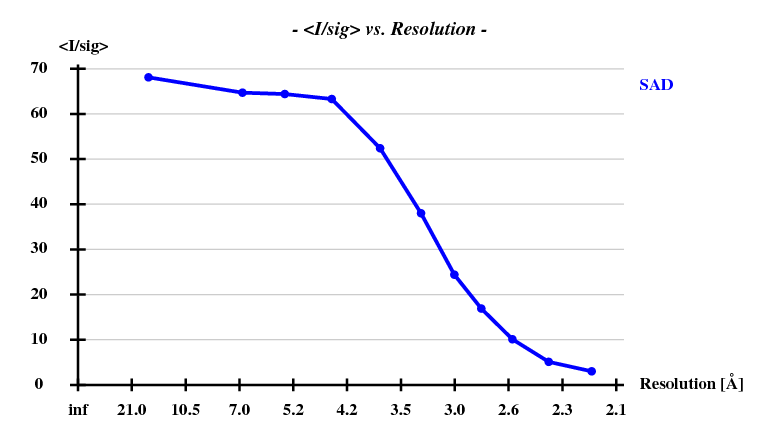
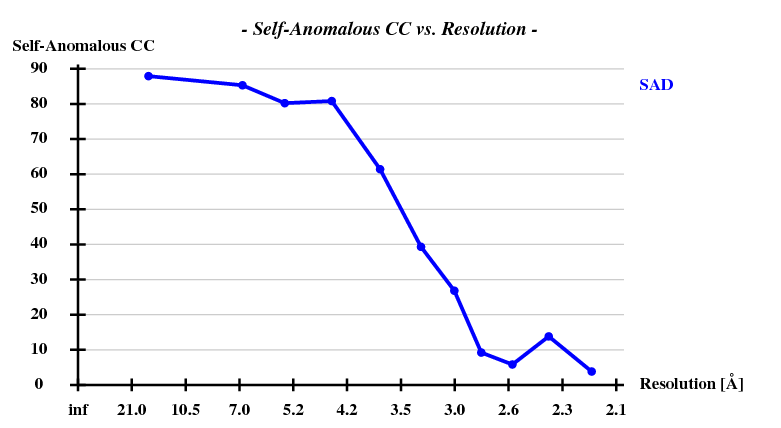 And then 100 trials of shelxd, trying to find 3 Se atoms at 30-3.3 resolution (I also tried 3.0 3.1 3.2 3.4 3.5 but 3.3 was best).
And then 100 trials of shelxd, trying to find 3 Se atoms at 30-3.3 resolution (I also tried 3.0 3.1 3.2 3.4 3.5 but 3.3 was best).
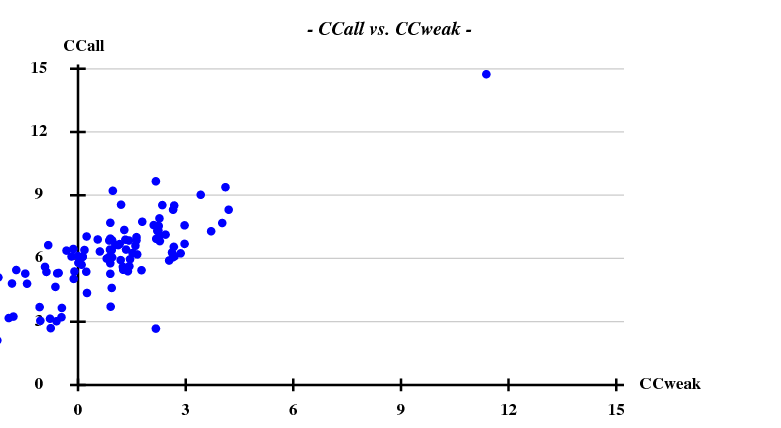
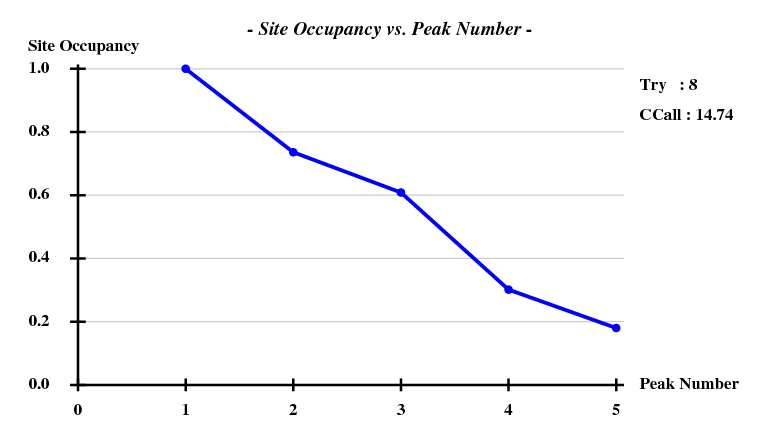 This looks reasonable although the absolute value of CCall is so low that there is little hope that the structure can be solved with this amount of information. And indeed, SHELXE did not show a difference between the two hands (in fact we even know that the "original hand" is the correct one since the inverted had would correspond to spacegroup #92 !).
This looks reasonable although the absolute value of CCall is so low that there is little hope that the structure can be solved with this amount of information. And indeed, SHELXE did not show a difference between the two hands (in fact we even know that the "original hand" is the correct one since the inverted had would correspond to spacegroup #92 !).
